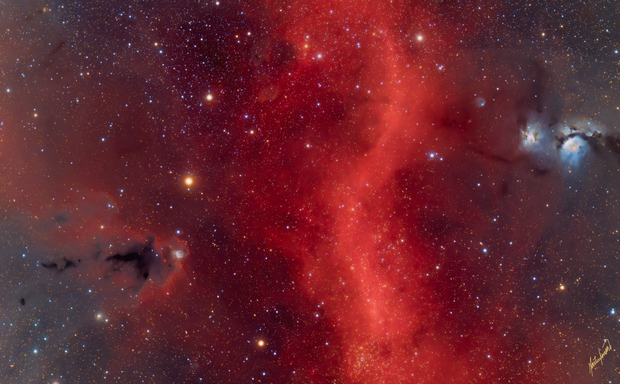
M78, Barnard´s Loop and LDN1622 in Orion
LDN 1622 is a dark nebula in Orion.
It is known as the Boogeyman Nebula due to both its shape and its dark color.
the obscuring dust of LDN 1622 is thought to be much closer than Orion's more famous nebulae, perhaps only 500 light-years away.
At that distance, this 1 degree wide field of view would span less than 10 light-years
The M78 nebula is a reflection nebula in the constellation of Orion, one of the brightest diffuse reflection nebula in the sky.
This nebulae belongs to the Orion Molecular Cloud Complex and is about 1,600 light years distant from Earth.
In between both targets is part of the Barnard´s Loop, which surrounds Orion´s Belt and the Orion Nebula (M42).
The technique I used was to bled starless version of an OSC RGB image and an OSC Duo-narrowband image.
These Two images combined formed the final RGB image which was then combined with the Luminance acquired with another setup.
Both setups were running in parallel and for this reason I was able to acquire 13h worth of data in one single night.
🗓 October, 23rd. 2022

Giruá, RS, Brazil. Bortle 4.

ASKAR FRA400 refractor (with reducer, 280mm DF f3.9), ASKAR FMA230

asi294mm camera, asi2600mc camera
🕶 Optolong L-PRO for luminance, Idas LPS-P3 for osc rgb, Idas NBZ for duo-narrowband osc.
- 108 x 180s Luminance (L-pro) frames (5,4h)
- 60 x 180s RGB (Idas LPS-P3) (3h)
- 39 x 300s Duo-Narrowband frames (3,25h)
- total integration time: ~11,65h

pixinsight, photoshop
[URL=https://astrob.in/tf0icz/0/][IMG]https://astrob.in/tf0icz/0/rawthumb/regular/get.jpg?insecure[/IMG][/URL]
M78, Barnard´s Loop and LDN1622 in Orion
LDN 1622 is a dark nebula in Orion.
It is known as the Boogeyman Nebula due to both its shape and its dark color.
the obscuring dust of LDN 1622 is thought to be much closer than Orion's more famous nebulae, perhaps only 500 light-years away.
At that distance, this 1 degree wide field of view would span less than 10 light-years
The M78 nebula is a reflection nebula in the constellation of Orion, one of the brightest diffuse reflection nebula in the sky.
This nebulae belongs to the Orion Molecular Cloud Complex and is about 1,600 light years distant from Earth.
In between both targets is part of the Barnard´s Loop, which surrounds Orion´s Belt and the Orion Nebula (M42).
The technique I used was to bled starless version of an OSC RGB image and an OSC Duo-narrowband image.
These Two images combined formed the final RGB image which was then combined with the Luminance acquired with another setup.
Both setups were running in parallel and for this reason I was able to acquire 13h worth of data in one single night.
🗓 October, 23rd. 2022
📍 Giruá, RS, Brazil. Bortle 4.
🔭 ASKAR FRA400 refractor (with reducer, 280mm DF f3.9), ASKAR FMA230
📷 asi294mm camera, asi2600mc camera
🕶 Optolong L-PRO for luminance, Idas LPS-P3 for osc rgb, Idas NBZ for duo-narrowband osc.
- 108 x 180s Luminance (L-pro) frames (5,4h)
- 60 x 180s RGB (Idas LPS-P3) (3h)
- 39 x 300s Duo-Narrowband frames (3,25h)
- total integration time: ~11,65h
🧑💻 pixinsight, photoshop